New Mars Forums
You are not logged in.
- Topics: Active | Unanswered
Announcement
#1 2020-12-14 13:38:53
- Quaoar
- Member
- Registered: 2013-12-13
- Posts: 665
Using the landing propellant tank as a storm cellar
Hi to all,
Here in Italy I was summoned again for the second wave, put in stand-by and never called. So I continue writing my SF novel.
I have a SpaceX like starship, and I thought to put the storm-cellar inside the landing propellant tank: with 164 tons of LOX-RP1 3.36 O/F ratio I have 48.8 tons of RP-1, so I can have a sphere of 8.4 m of diameter with 20 g/cm2 of RP-1 as a storm cellar for the crew, sparing a lot of mass. I would like to ask to the experts of this forum if it might be a good solution and if it is possible to do the same with cryogenic propellants like L-CH4.
Thanks to all.
Last edited by Quaoar (2020-12-14 13:40:06)
Offline
Like button can go here
#2 2020-12-14 14:08:44
- RobertDyck
- Moderator
- From: Winnipeg, Canada
- Registered: 2002-08-20
- Posts: 8,231
- Website
Re: Using the landing propellant tank as a storm cellar
Yes, it's an idea. However, some details. Falcon 9 and Falcon Heavy use LOX/RP1, however Starship uses LOX/LCH4. Falcon Heavy upper stage is 3.66m diameter x 12.6m long. That length is not an individual tank, it's overall length including engine. Although Falcon Heavy could launch a Dragon capsule to Mars, SpaceX has no intention to do so. And the upper stage has no landing mechanism. Starship is 9m diameter. External tank of Shuttle was 8.4m diameter, so Ares launch vehicle proposed in 1990 as part of Mars Direct was also 8.4m diameter. Robert Zubrin and his partner David Baker made the habitat the same diameter as the launch vehicle core stage in order to maximize living space. But Starship is 9m diameter x 50m high. That height includes non-disposable fairing around engines, passenger compartment in the nose, etc. That height does not include the Super Heavy booster, just the part that lands on Mars. While Falcon uses aluminum-lithium alloy similar to external tank of Shuttle, Starship is built with stainless steel 304L. The "L" means low carbon; it's less stiff but doesn't have to be annealed after welding. That alloy should be even better as a pressurized habitation volume.
Exact details of Starship keep changing, but here's one cutaway from 2018: (click image for article I got it from)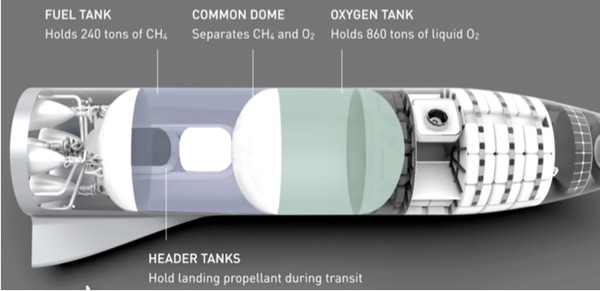
Oh! Elon's plans include sending cargo Starships one-way to Mars with supplies before settlers arrive. So there will be some ships standing around that you could use. But nose won't have decks, airlock, lifesupport, etc. Instead inside should be a cargo hold.
Offline
Like button can go here
#3 2020-12-14 16:32:00
- SpaceNut
- Administrator
- From: New Hampshire
- Registered: 2004-07-22
- Posts: 29,623
Re: Using the landing propellant tank as a storm cellar
Good to hear from you and be safe in the second wave of service to others....
From the landing video's we would be hard pressed to see the ship on its side for use which make for the need for crane services on mars to make use of the ship. Even if we cut the nose area of the ship from the remaining we would still need a crane.
Making use of the fuel tanks are also problematic in that they are not like the way a shuttles or others are being made. They lack structural strength needed to pile the regolith onto them.
Now if the nose cargo entry is an air lock one could make use of its section to build with in but it would need lots of work to make it useable.
Offline
Like button can go here
#4 2020-12-14 17:18:37
- RobertDyck
- Moderator
- From: Winnipeg, Canada
- Registered: 2002-08-20
- Posts: 8,231
- Website
Re: Using the landing propellant tank as a storm cellar
Yea, the tank would have to be pressurized to hold the weight of regolith on top. Starship was assembled and welded outdoors, so could be dismantled and reassembled outdoors on Mars as well. Here's serial# 1 from February 2020. Note a single header tank in the nose instead of separate LOX & LCH4 header tanks in the main LCH4 tank.
A close-up of assembly. Don't know which SN this is. It puts size in perspective.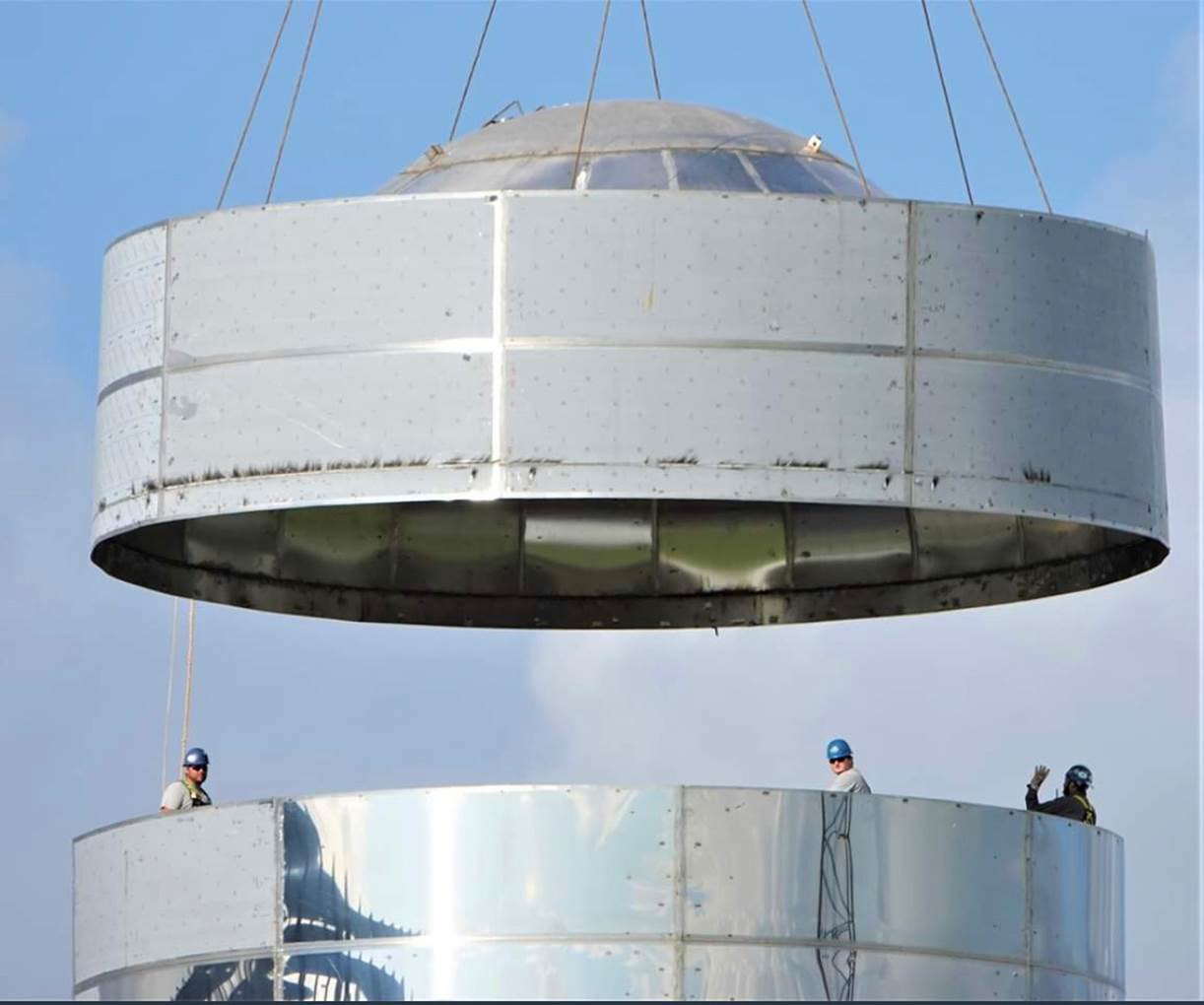
And a render of SN6. This shows one header tank in bulkhead between LOX & LCH4, the other header tank in nose. Yes, it's rendered on its side but lands vertical on its tail.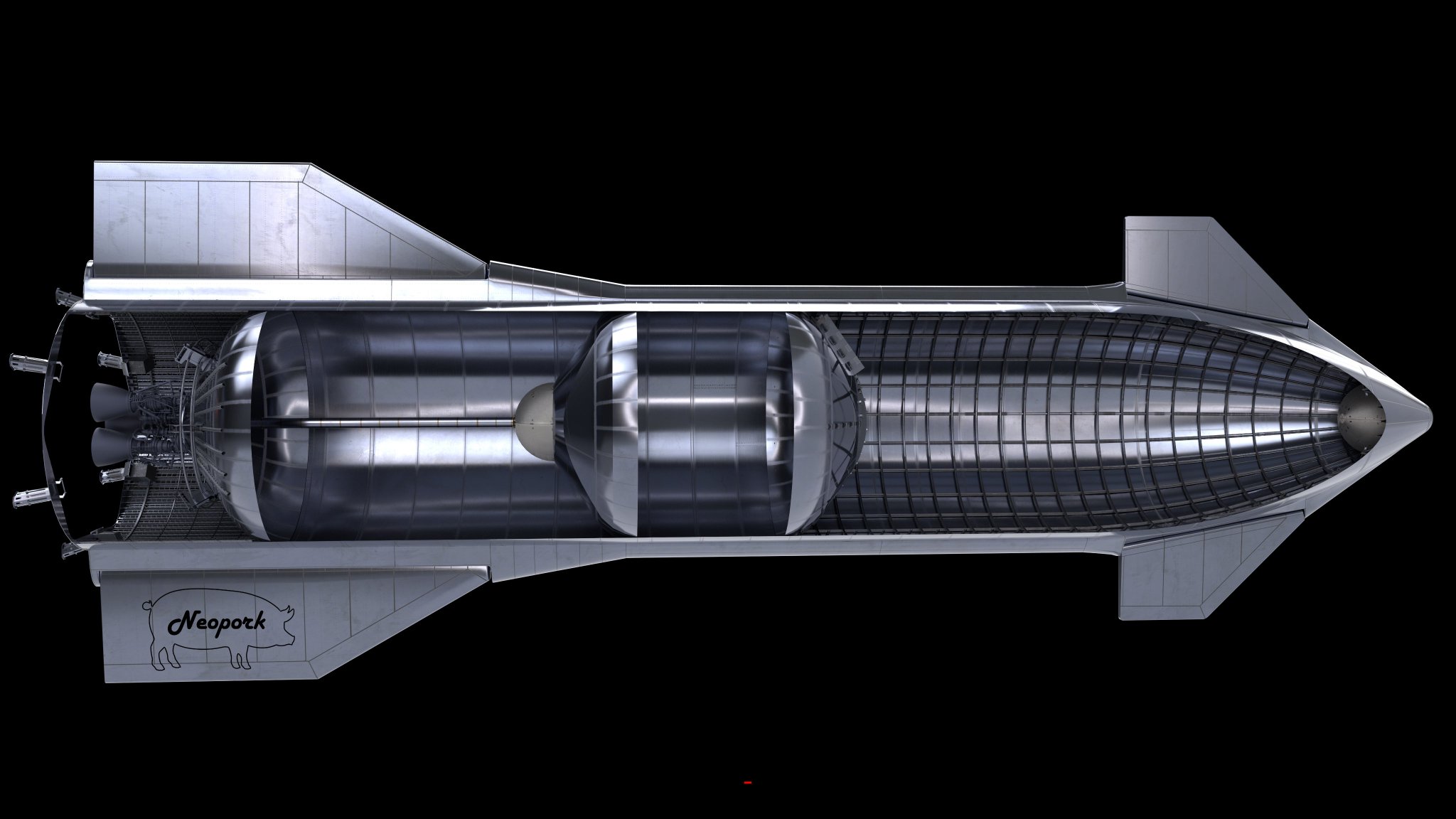
Offline
Like button can go here
#5 2020-12-15 14:32:13
- Quaoar
- Member
- Registered: 2013-12-13
- Posts: 665
Re: Using the landing propellant tank as a storm cellar
Yea, the tank would have to be pressurized to hold the weight of regolith on top. Starship was assembled and welded outdoors, so could be dismantled and reassembled outdoors on Mars as well. Here's serial# 1 from February 2020. Note a single header tank in the nose instead of separate LOX & LCH4 header tanks in the main LCH4 tank.
https://i.redd.it/d4j68aljuch41.png
A close-up of assembly. Don't know which SN this is. It puts size in perspective.
https://techcrunch.com/wp-content/uploa … cex-2.jpeg
And a render of SN6. This shows one header tank in bulkhead between LOX & LCH4, the other header tank in nose. Yes, it's rendered on its side but lands vertical on its tail.
https://pbs.twimg.com/media/EgCRXWFXkAEWsli.jpg:large
My spaceship is a "habi-lander": a 60 meters long 10 meters diam, stainless steel spaceship that is carried by a vapor-core modular nuclear spaceship (like GW's design http://exrocketman.blogspot.com/2012/07 … icial.html ), then she detaches herself from the mother spaceship and lands on the planet whit 48 colonists, who live inside it during the trip, while the nuclear spaceship parks herself in orbit, waiting for the launch window, then she departs with a little habitat for a crew of 6. The habi-lander has a dry mass of 326 tons and carries 164 tons of landing propellant: I chose LOX-RP1 because RP1 is not cryogenic and can be used as a screening mass for solar flares. The landing rockets are 24 SpaceX Merlin mounted at the sides of the fuselage for belly landing.
Last edited by Quaoar (2020-12-15 16:43:27)
Offline
Like button can go here
#6 2020-12-15 16:42:24
- RobertDyck
- Moderator
- From: Winnipeg, Canada
- Registered: 2002-08-20
- Posts: 8,231
- Website
Re: Using the landing propellant tank as a storm cellar
I posted images of one individual's rendering of what he thinks the inside of Starship will look like. That's based on computer graphics SpaceX released of the outside, on actual images of real Starship prototypes from the outside, and verbal description Elon Musk gave of what will be inside. Rather than repost, I'll post a link
http://newmars.com/forums/viewtopic.php … 70#p172070
Reasons Elon is looking at LCH4 for Mars:
higher specific impulse
almost same storage temperature as LOX. By storing LCH4 just a 21°C colder than it's boiling temperature than O2, they can be the same temperature.
liquid storage temperature at pressure is below ambient temperature of space, so a sunshade is enough to keep it liquid
can be made on Mars
I don't know Starship cryogenic pressure, but Shuttle's external tank reached 38 psi (260 kPa) for LH2, 25 psi (170 kPa) for LOX. Normal pressure when sitting on the launch pad for LOX was 20 to 22 psig, but could achieve 25 psi during launch.
LOX boils at -182.96°C @ 1 atmosphere pressure, freezes -218.78°C. RP-1 freezes at -73°C, boils +147°C. So with RP-1 you need more than a thin metal bulkhead.
Offline
Like button can go here
#7 2020-12-15 16:56:07
- Quaoar
- Member
- Registered: 2013-12-13
- Posts: 665
Re: Using the landing propellant tank as a storm cellar
I posted images of one individual's rendering of what he thinks the inside of Starship will look like. That's based on computer graphics SpaceX released of the outside, on actual images of real Starship prototypes from the outside, and verbal description Elon Musk gave of what will be inside. Rather than repost, I'll post a link
http://newmars.com/forums/viewtopic.php … 70#p172070Reasons Elon is looking at LCH4 for Mars:
higher specific impulse
almost same storage temperature as LOX. By storing LCH4 just a 21°C colder than it's boiling temperature than O2, they can be the same temperature.
liquid storage temperature at pressure is below ambient temperature of space, so a sunshade is enough to keep it liquid
can be made on Mars
I don't know Starship cryogenic pressure, but Shuttle's external tank reached 38 psi (260 kPa) for LH2, 25 psi (170 kPa) for LOX. Normal pressure when sitting on the launch pad for LOX was 20 to 22 psig, but could achieve 25 psi during launch.
LOX boils at -182.96°C @ 1 atmosphere pressure, freezes -218.78°C. RP-1 freezes at -73°C, boils +147°C. So with RP-1 you need more than a thin metal bulkhead.
SpaceX Starship is perfect for Mars where the CO2 atmosphere can be used to synthesize CH4 via Sabatier reaction and Mars low gravity consents to reach orbit and depart in one stage. The planet target of my novel is not Mars but a superearth (via a wormhole orbiting between Earth and Venus): the exoplanet has a breathable atmosphere of 1.3 bar and a surface gravity of 1.3 G so a SSTO is impossible with current technology and the habi-lander is a one-way ship that is converted in a ground habitat after landing. The colonists remain on the planet, while the crew reach the mother-ship with a two-stage ascender, with LOX-LH2 rockets. Return propellant is made via electrolysis from water: I think LOX-LH2 is the easiest propellant to make in a earth-like planet with a nitrogen and oxygen atmosphere.
Last edited by Quaoar (2020-12-15 17:00:00)
Offline
Like button can go here
#8 2020-12-15 17:29:12
- SpaceNut
- Administrator
- From: New Hampshire
- Registered: 2004-07-22
- Posts: 29,623
Re: Using the landing propellant tank as a storm cellar
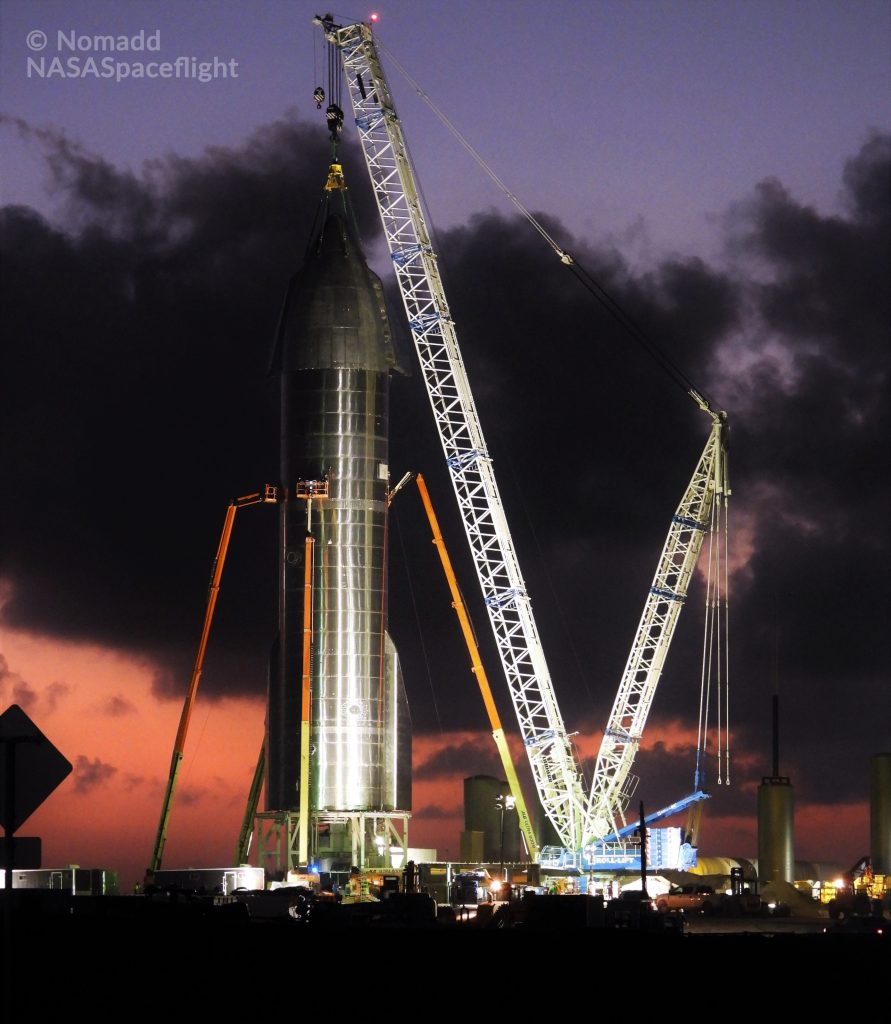
Now, on October 22nd, SpaceX has successfully stacked the rocket to its full height, installing the just-finished nose section to effectively complete the first flightworthy ~50m (~165 ft) tall Starship prototype.
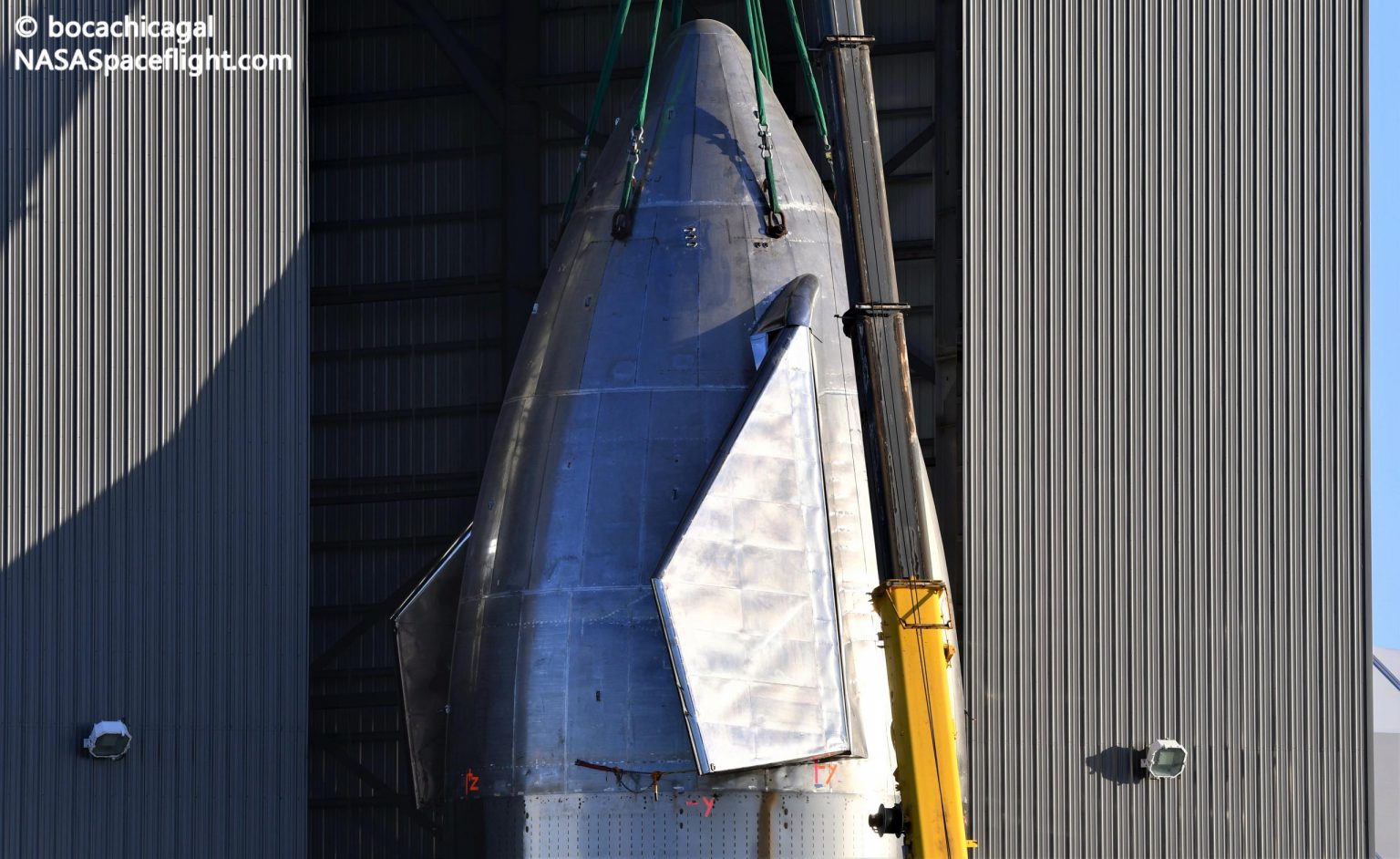
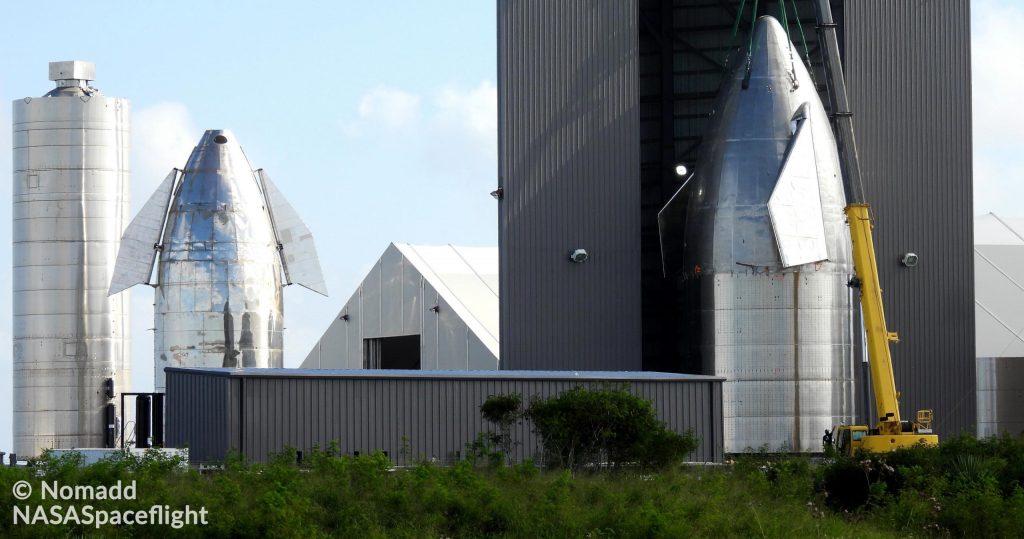
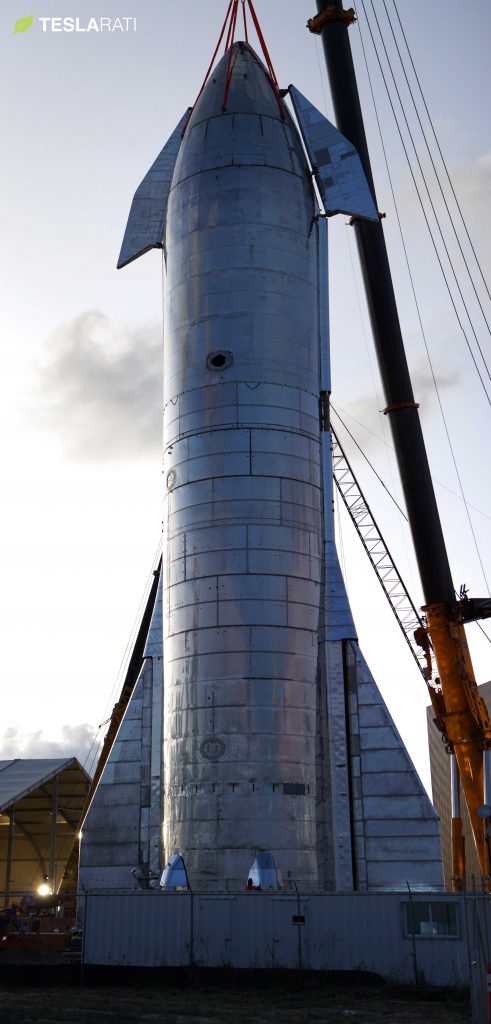
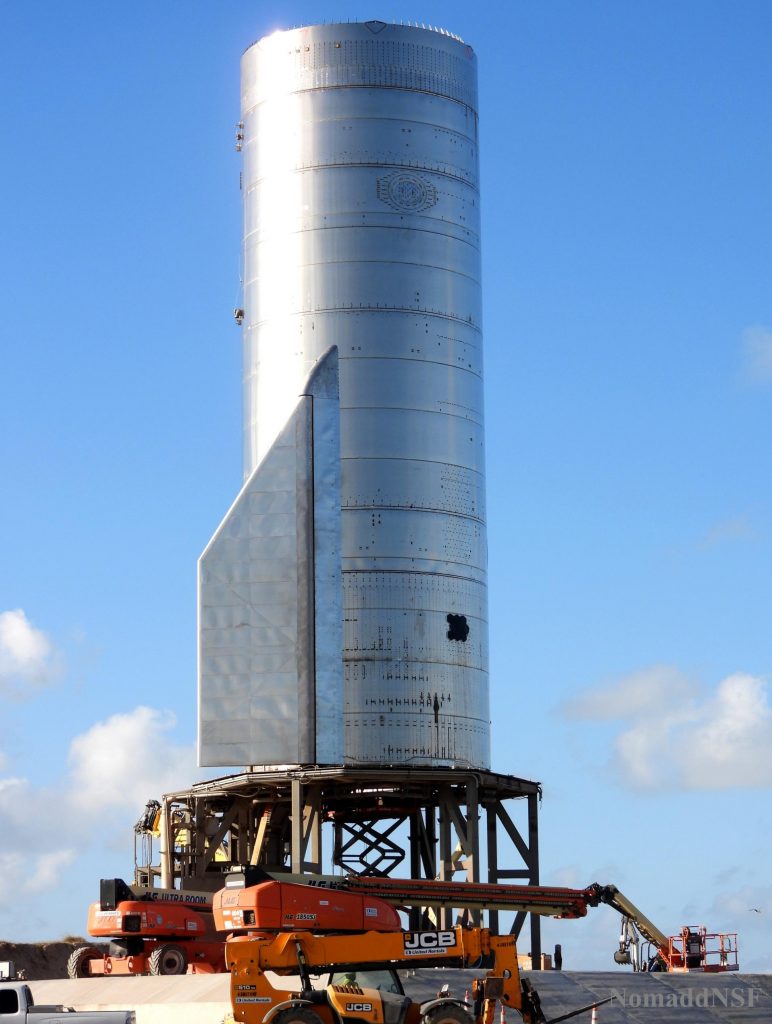
Looks like a total of 5 cranes of 3 different sizes are need to move the nose around and that a band is used to attach them together...
Offline
Like button can go here
#9 2020-12-15 18:29:32
- RobertDyck
- Moderator
- From: Winnipeg, Canada
- Registered: 2002-08-20
- Posts: 8,231
- Website
Re: Using the landing propellant tank as a storm cellar
Um, well, you asked advice from those on this forum. And you asked if the same could be done with cryogenic propellants like L-CH4.
Liquid hydrogen boils at -252.78°C, spacesuit temperature in Earth orbit is ±250°F, +121°C to -156.67°C, but usually represented as +120°C to -150°C. So with moderate pressure and carefully shading the tank, you can keep LOX and LCH4 liquid. Transit to Venus will be warmer on the sun side, but the same on the dark side. This means LH2 requires active refrigeration.
LOX and RP-1 remain liquid at different temperatures. If your ship uses LOX, it may as well use LCH4. Apollo SM main engine used N2O4 and Aerozine 50, a 50:50 mix by weight of UDMH and hydrazine. Both Apollo propellants remained liquid at room temperature, so temperature control during transit wasn't an issue. LOX/LCH4 has higher Isp and safer.
You said your mother ship will use vapour core nuclear, then why not use that for the lander? Especially if you use LH2 propellant. An open cycle gas core nuclear thermal rocket was estimated at 6,000s Isp in the 1960s; later designs estimate up to 9,000s. At that Isp, an SSTO in 1.3 G could work. Don't know how much radiation would contaminate the landing zone. An alternative is a winged lander. With a lifting body, you could land on a dry lake bed like Shuttle. Take off with a jet engine to get away from habitation before igniting the OC GCNTR.
Offline
Like button can go here
#10 2020-12-16 06:25:04
- Quaoar
- Member
- Registered: 2013-12-13
- Posts: 665
Re: Using the landing propellant tank as a storm cellar
Um, well, you asked advice from those on this forum. And you asked if the same could be done with cryogenic propellants like L-CH4.
Liquid hydrogen boils at -252.78°C, spacesuit temperature in Earth orbit is ±250°F, +121°C to -156.67°C, but usually represented as +120°C to -150°C. So with moderate pressure and carefully shading the tank, you can keep LOX and LCH4 liquid. Transit to Venus will be warmer on the sun side, but the same on the dark side. This means LH2 requires active refrigeration.
LOX and RP-1 remain liquid at different temperatures. If your ship uses LOX, it may as well use LCH4. Apollo SM main engine used N2O4 and Aerozine 50, a 50:50 mix by weight of UDMH and hydrazine. Both Apollo propellants remained liquid at room temperature, so temperature control during transit wasn't an issue. LOX/LCH4 has higher Isp and safer.
You said your mother ship will use vapour core nuclear, then why not use that for the lander? Especially if you use LH2 propellant. An open cycle gas core nuclear thermal rocket was estimated at 6,000s Isp in the 1960s; later designs estimate up to 9,000s. At that Isp, an SSTO in 1.3 G could work. Don't know how much radiation would contaminate the landing zone. An alternative is a winged lander. With a lifting body, you could land on a dry lake bed like Shuttle. Take off with a jet engine to get away from habitation before igniting the OC GCNTR.
Thank Bob, the documents you have posted about Starship are very usefull and interesting.
The problem of my habi-tank is that the landing propellant has to be used as screening mass during the 180 days of travel Earth-wormhole (at the exit of the wormhole we are in the system of a red dwarf, so the transfer orbit to the super-earth is only 9 days.) RP1 is liquid at room temperature so we can build a double wall tank with the storm-cellar surrounded by the propellant. I don't know if refrigeration systems can allow a 48-people storm cellar surrounded by 20 g/cm2 liquid CH4, without boiling the propellant of freezing the people.
They cannot use a gas core NTR because in my novel is set in a near future (2220), where humanity is in decline, coastal towns like NY are mostly underwater for the global warming meltdown, and technology is frozen at the beginning of the XXI century. So they have a NERVA-derived vapor core NTR projected by Dougan and Diaz (https://www.google.com/url?sa=t&rct=j&q … LYs2231OZ0) but not a functional gas-core. DD's vapor-core has a T/W ratio of 5, good for an orbit-to-orbit spaceship but too low for taking-off from ground, where chemical rocket are still used. The tech is frozen so they still use RS-25 derived LOX-LH2 rocket busters.
Have you some link of 9000 s gas-core?
Last edited by Quaoar (2020-12-16 06:32:00)
Offline
Like button can go here
#11 2020-12-16 09:22:58
- tahanson43206
- Moderator
- Registered: 2018-04-27
- Posts: 22,498
Re: Using the landing propellant tank as a storm cellar
For Quaoar re Science Fiction project ...
The premise of your story is interesting, and the physics seems (to my impression anyway) as well within the range of Science Fiction of the Analog level, which is where my focus has been for a while.
The only plot element that is going to require reader acceptance is the worm hole, and by now most readers should accept that and just go with the flow from there.
By any chance, are you interested in considering a collaborator to help with dialog? I have someone in mind, although the candidate is ** much ** younger, and lives in a different part of Europe. Recently a collaboration between a master story teller and a top tier physicist came (back) to my attention. They've been mentally jousting with each other in a stretch area of known physics.
In your case, the plot element of building the technology at a level which can be accepted by the average (science fiction) reader is attractive (again, to my point of view).
Edit#1: As far as radiation shielding is concerned ... The use of electrostatic shielding is an idea that goes back to the 1970's. I've reported to this forum on that work, elsewhere in the forum archive. If you're interested, I would be willing to look for the posts where that information is recorded.
Edit#2: Your skill with English is obvious, so I am assured you are able to use at least two languages fluently. The audience for your work will be increased by the number of languages in which it is offered.
Do you have other languages on tap as well?
(th)
Offline
Like button can go here
#12 2020-12-18 10:53:10
- Quaoar
- Member
- Registered: 2013-12-13
- Posts: 665
Re: Using the landing propellant tank as a storm cellar
For Quaoar re Science Fiction project ...
The premise of your story is interesting, and the physics seems (to my impression anyway) as well within the range of Science Fiction of the Analog level, which is where my focus has been for a while.
The only plot element that is going to require reader acceptance is the worm hole, and by now most readers should accept that and just go with the flow from there. (th)
I like realistic "hard-fiction" but interstellar travels are impossible with current technology: a wormhole in the solar system is a trick that allow me to travel between stars with Hohmann orbits and NERVA-derived NTRs.
By any chance, are you interested in considering a collaborator to help with dialog? (th)
I surely will need some help for the dialogs when I write the English edition. By now I've just finished the first two books of the saga in Italian, but I haven't published them because in the next books I'll probably have to go back and change something to make ends meet.
In your case, the plot element of building the technology at a level which can be accepted by the average (science fiction) reader is attractive (again, to my point of view).(th)
I use very simple technology: a modular spaceship with 9 vapor-core NTR (1000s Isp 415 kN of thrust) and a magnetoshell for areo-magnetic capture at both ends (https://www.nasa.gov/directorates/space … netoshell/) (otherwise mission delta-V would be prohibitive even for a nuclear spaceship), and a SpaceX Starship-derived habi-lander with control winglets and 24 Merlin landing rockets on the belly. After landing the characters travel on the planet mostly via vintage flying-boats with hydrogen turboprops.
Edit#1: As far as radiation shielding is concerned ... The use of electrostatic shielding is an idea that goes back to the 1970's. I've reported to this forum on that work, elsewhere in the forum archive. If you're interested, I would be willing to look for the posts where that information is recorded.(th)
ES needs a very high positive voltage to stop protons and strong magnetic fields to deflect electrons accelerated by the positive electrostatic fields: the hardware mass is more than a storm cellar surrounded by 20 g/cm2 of kerosene, which is also needed as landing propellant.
Edit#2: Your skill with English is obvious, so I am assured you are able to use at least two languages fluently. The audience for your work will be increased by the number of languages in which it is offered.
Do you have other languages on tap as well?
(th)
I also speak some broken Japanese, but I can write fluently only in Italian and English
Last edited by Quaoar (2020-12-18 17:44:33)
Offline
Like button can go here
#13 2020-12-19 08:19:09
- tahanson43206
- Moderator
- Registered: 2018-04-27
- Posts: 22,498
Re: Using the landing propellant tank as a storm cellar
For Quaoar re #12
First, thank you for your detailed (and information rich) reply!
There is a chance the young gent I have in mind to help with English translation is "listening", so I will merely try to encourage him to contact you.
Because this topic is highly specific, I will honor the tight focus by opening a new topic about ES, which you have (kindly) offered.
Regarding the tank shelter idea.... It should be possible to measure the performance of the shelter mathematically. The most worrisome projectiles to be addressed are iron atoms without electrons moving at close to the speed of light.
There are numerous references to these interesting objects in the forum. A member named JOSHNH4H invested some time thinking about them, and there is at least one post about a research facility where they are studied on Earth using a purpose built detector.
The desirable state (from my perspective) is a total influx of ZERO charged particles of sufficient strength to injure a living creature. I'm not sure about free flying neutrons, but I assume they are present in the cosmic soup.
The question to be answered is how effective the shelter you have proposed would be. It should be possible to devise a software model that would provide a reasonable level of certainty about the performance of your design. Alternatively, there may be a National agency that would be willing to fund an actual experiment on an actual outpost, well away from Earth and therefore in harm's way.
(th)
Offline
Like button can go here
#14 2020-12-20 14:01:03
- Quaoar
- Member
- Registered: 2013-12-13
- Posts: 665
Re: Using the landing propellant tank as a storm cellar
For Quaoar re #12
First, thank you for your detailed (and information rich) reply!
There is a chance the young gent I have in mind to help with English translation is "listening", so I will merely try to encourage him to contact you.
Because this topic is highly specific, I will honor the tight focus by opening a new topic about ES, which you have (kindly) offered.
Regarding the tank shelter idea.... It should be possible to measure the performance of the shelter mathematically. The most worrisome projectiles to be addressed are iron atoms without electrons moving at close to the speed of light.
There are numerous references to these interesting objects in the forum. A member named JOSHNH4H invested some time thinking about them, and there is at least one post about a research facility where they are studied on Earth using a purpose built detector.
The desirable state (from my perspective) is a total influx of ZERO charged particles of sufficient strength to injure a living creature. I'm not sure about free flying neutrons, but I assume they are present in the cosmic soup.
The question to be answered is how effective the shelter you have proposed would be. It should be possible to devise a software model that would provide a reasonable level of certainty about the performance of your design. Alternatively, there may be a National agency that would be willing to fund an actual experiment on an actual outpost, well away from Earth and therefore in harm's way.
(th)
20 g/cm2 of kerosene cannot stop 2 GeV protons and heavy ions of GCR, but the GCR background is not a problem in a less than three months travel in the inner solar system: its only task is to stop the 200 MeV protons of solar mass ejections. A years-long travel in the outer solar system will probably need some kind of GCR shielding like superconductive coils magnetic shielding or ES, but the spaceship of my book has only to go to a wormhole at 0.85 UA from the sun, where a Hohmann transfer takes 161 days.
Last edited by Quaoar (2020-12-20 14:05:05)
Offline
Like button can go here
#15 2020-12-20 14:47:19
- tahanson43206
- Moderator
- Registered: 2018-04-27
- Posts: 22,498
Re: Using the landing propellant tank as a storm cellar
For Quaoar re topic...
A formula for writing novels (or at least stories) is to create a sense of caring for the characters, then to put the characters in danger, kill off some of them, and then rescue the rest, for a happy ending.
In the case of the storm shelter, I can easily imagine how it would become an important plot element at some point, along with conflicts between characters that are likely to arise regardless of the circumstances.
Writing dialog is a skill that is gifted to some and not to others. I hope it flows easily for you. With two novels of a series completed, I am guessing you're feeling fairly happy with the results so far.
(th)
Offline
Like button can go here